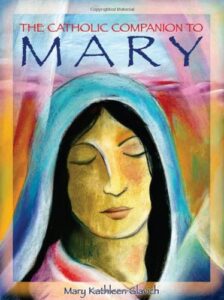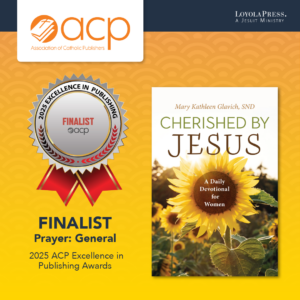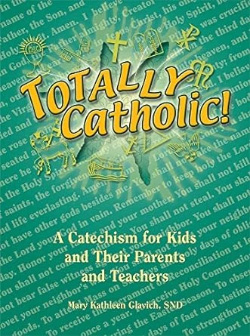
My nephew Andy recently brought me a gift from Guatemala: the most beautiful rosary I’ve ever seen, the blue one pictured here. As its name implies, the rosary is a prayer comparable to offering Our Blessed Mother a garland of roses. Since we are in October, the month of the rosary, I offer you some facts about this Catholic prayer, mainly lifted from my book The Catholic Companion to Mary.
In the wake of the tragedy of September 11, 2001, Pope John Paul II urged individuals, families and communities to pray the rosary “possibly every day, for peace, so that the world can be preserved from the wicked scourge of terrorism.” (Supernatural help is needed more than ever today!)
A university student sitting on a train next to an old man praying the rosary remarked, “I don’t believe in such silly things. Take my advice. Throw the rosary out of this window and learn what science has to say.” “Science? I don’t understand,” replied the man. “Maybe you can explain it to me.” The student offered, “Give me your address and I’ll send you some literature.” Fumbling in his pocket, the old man drew out his business card. The boy looked at the card and burned with embarrassment. It read, “Louis Pasteur, Director of the Institute of Scientific Research, Paris.”
Joseph Haydn, eighteenth-century composer, always carried his rosary and prayed it. Chaucer, who lived in the fourteenth century, had his portrait painted holding a rosary. Martin Luther prayed the rosary all his life. In her visits to earth, Mary exhorted us to pray the rosary, especially for peace.
A blessed rosary is a sacramental, that is, an object whose use brings special graces through the prayers and merits of the Church. It is called “the Gospel on beads.” Basic Catholic prayers of the rosary are rooted in Scripture: The Apostles’ Creed, the Our Father, and the Hail Mary. While praying these prayers, we also reflect on mysteries in the life of Christ. In this way, praying the rosary is like praying the memories of Mary. In fact we are imitating her, who “kept all these things in her heart.”
The rosary is a very physical prayer. As we touch the beads, the rosary involves not only our bodies but the stuff of creation—wood, metal, stone, plastic, even seeds, used to make some rosaries.
Origins of the Rosary

Although the Dominicans did much to promote praying the rosary, the story that it began when Mary gave a rosary to St. Dominic is only a legend. Christians were praying on beads a hundred years before him, and the original fifteen mysteries were only added two hundred years after he lived. The rosary has evolved through the centuries and continues to evolve. For example, five new mysteries were added in 2002, the first major change in the rosary in over 500 years.
How then did the rosary originate? Long ago when the Church prayed the 150 psalms, illiterate people substituted praying 150 Our Fathers (called Paternosters in Latin) on beads. (In Anglo-Saxon bede was the word for “prayer.”) In the early eleventh century Lady Godiva (known for her legendary daring ride through the streets of Coventry, England) bequeathed her prayer-chain of precious stones to the Church.
In the twelfth century, when the Hail Mary was formulated, people began praying this prayer instead of the Our Father. The rosary became known as Our Lady’s Psalter (psalm book). Sometimes genuflections and even prostrations accompanied each prayer.
Eventually, the rosary beads were grouped into decades (sets of ten) with another bead between each decade, and as each decade was prayed, one mystery was meditated upon. In time, there were three sets of five mysteries each: the Joyful, Sorrowful and Glorious. In 2002, Pope John Paul II added the fourth set: the Mysteries of Light, or Luminous Mysteries, which are events from Jesus’ public life. These new mysteries filled the gap between the joyful mysteries of Jesus’ early life and the sorrowful mysteries of his death.
In 1571, Muslims were attacking Catholic countries and the Turks were sailing to Italy. Pope Pius V, who was a Dominican, urged the praying of the Rosary, and the Turks were defeated on October 7 in the Battle of Lepanto. The pope declared October 7 the Feast of Our Lady of Victory. Soon after, this was changed to the Feast of Our Lady of the Rosary.
At Lourdes, Mary appeared with a rosary suspended from her arm and told St. Bernadette to pray her rosary. Our Blessed Mother joined in on the Our Fathers and Glory Be prayers. At Fatima, Our Lady urged the three children who saw her to pray the rosary for peace. She called herself Our Lady of the Rosary. St. John Paul II declared that the Rosary was his favorite prayer.
How to Pray the Rosary
Some say that they can’t pray the rosary because it requires doing two things at once: praying Hail Marys and thinking about a mystery, but this is no more impossible than it is to eat and watch television at the same time. The Hail Marys become a kind of background music while we reflect on the mystery. They are comparable to the Jesus Prayer or any mantra that is repeated as a springboard for union with God. Because of the soothing rhythm of the rosary’s repetitions, some people pray it when they have trouble sleeping at night.
There are ways to insure that we are really praying and not just saying the rosary. Having a specific intention for the rosary helps motivate us to pray it well. Another tip is to spend a minute at the beginning of each decade concentrating on the mystery. At that time we might ask for the grace to grow in a virtue related to that event too. We can also be creative and pray our own mysteries, contemplating, for example, on five of Jesus’ many parables, or on five of his miracles, or on the mysteries of our family or work lives.
Beginning
Make the Sign of the Cross with the crucifix and pray the Apostles’ Creed.
On the single bead pray an Our Father.
On the three beads pray Hail Marys.
On the single bead pray a Glory Be to the Father.
For Each Decade
Pray an Our Father on the single bead. Pray ten Hail Marys. Conclude with a Glory Be to the Father.
Ending
Hail, Holy Queen, Mother of Mercy! Our Life, our sweetness, and our hope! To you do we cry, poor banished children of Eve; to you do we send up our sighs, mourning and weeping in this valley of tears. Turn, then, most gracious advocate, your eyes of mercy toward us; and after this our exile, show unto us the blessed fruit of thy womb, Jesus. O clement, O loving, O sweet Virgin Mary. Pray for us, O holy Mother of God, that we may be made worthy of the promises of Christ.
You many also finish the rosary by adding any or all of the following prayers:
O God, whose only-begotten Son, our Lord Jesus Christ, has by his life, death, and resurrection purchased for us the rewards of eternal life, grant we beseech you that through meditating on these mysteries of the most holy rosary of the Blessed Virgin Mary, we may imitate what they contain and obtain what they promise, through the same Christ, our Lord. Amen.
May the divine assistance remain always with us. Amen.
And may the souls of the faithful departed, through the mercy of God, rest in peace. Amen.
The Mysteries of the Rosary
Looking over the mysteries, it’s easy to see why Pope Paul VI called the rosary the epitome of the Gospel. If you pray the entire rosary at one time over over several days, the mysteries are prayed as follows: Joyful, Luminous, Sorrowful, Glorious. If you pray the rosary every day or most days, the traditional days for each set of mysteries are as follows:
❖ Joyful Mysteries: Monday and Saturday
❖ Luminous Mysteries: Thursday
❖ Sorrowful Mysteries: Tuesday and Friday
❖ Glorious Mysteries: Sunday and Wednesday
The Scripture verses for each mystery is related to are listed in my book. They can also be found on the Internet.
How has the rosary played a role in your life?









